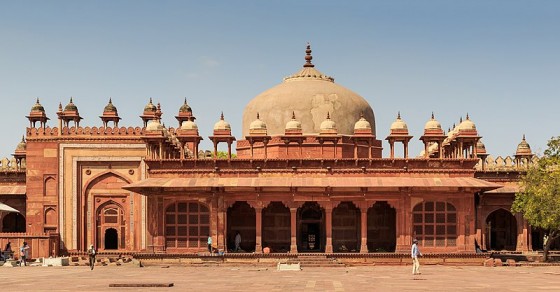


Ibadat Khana, Fatehpur Sikri: A Monument of Religious Tolerance and Mughal Splendor Located within the grand Fatehpur Sikri complex, Ibadat Khana stands as one of the most significant and thought-provoking structures from the Mughal era. Nearest Bus Stop: Fatehpur Sikri Bus Stand (Approx. 2 km away) Nearest Railway Station: Fatehpur Sikri Railway Station (Approx. 4 km away) Nearest Metro Station: Taj Mahal Metro Station, Agra (Approx. 37 km away) Nearest Airport: Agra Airport (Kheria) ? Approx. 40 km away. Indira Gandhi International Airport in Delhi is about 220 km away, offering convenient access for international travelers.
Located within the grand Fatehpur Sikri complex, Ibadat Khana stands as one of the most significant and thought-provoking structures from the Mughal era. Built in 1571 by Emperor Akbar, this architectural marvel served as a place of worship and spiritual gatherings, where the emperor hosted theological debates and discussions among scholars, saints, and religious leaders from various faiths. It is a symbol of Akbar's quest for religious tolerance and his interest in promoting dialogue and understanding between different religions. Today, Ibadat Khana is not just an architectural gem but a living testament to the Mughal Empire?s commitment to unity and harmony. Its historical significance and unique design make it one of the must-visit attractions in Fatehpur Sikri, offering a fascinating insight into the emperor's vision of a multicultural empire. Historical Significance Ibadat Khana was constructed by Akbar as a venue for religious discussions, particularly to facilitate interfaith dialogues. The emperor was deeply interested in exploring different religious philosophies and encouraging peaceful coexistence among the diverse religious communities within his empire. The Ibadat Khana is known for hosting the religious debates (called "Mahanubhav") between scholars of Islam, Hinduism, Christianity, Jainism, and other faiths, all with Akbar as the impartial listener. These debates not only showcased the emperor's progressive thinking but also demonstrated his commitment to promoting religious tolerance and understanding among different sects. It is believed that Ibadat Khana played a pivotal role in the formulation of Din-i Ilahi, Akbar?s syncretic religion, which sought to blend the best elements of various religions into a unified spiritual framework. Although Din-i Ilahi did not survive beyond Akbar?s reign, the Ibadat Khana remains a landmark in the history of religious and cultural dialogue. Architectural Features The Ibadat Khana is an exquisite example of Mughal architecture, blending elements of Islamic, Persian, and Indian styles. The building is designed with a focus on symmetry, balance, and an open, airy layout to facilitate large gatherings. Here are some key architectural features of Ibadat Khana: Square Building with Central Courtyard: The Ibadat Khana is a square-shaped building with an open central courtyard, typical of Mughal design. This layout not only served practical purposes, such as accommodating a large number of people, but also helped in maintaining a cool, airy environment. Decorative Arches and Pillars: The structure is adorned with beautiful arches, pillars, and decorative stonework. The arches that surround the central space are intricately carved with geometric patterns, floral motifs, and calligraphic inscriptions, highlighting the skilled craftsmanship of the Mughal artisans. High Roof and Central Dome: The roof of Ibadat Khana is crowned with a large central dome, a defining feature of Mughal architecture. The dome is designed to symbolize the vastness and spiritual openness of the building, providing a sense of grandeur and height. Columns and Hallways: The interior of the Ibadat Khana features tall columns supporting the roof, with long hallways that lead to various sections of the building. These columns are adorned with ornate carvings and are essential in maintaining the structural integrity of the building. Stone Inlay Work: The structure also displays exquisite stone inlay work on the walls, with patterns and motifs inspired by nature. These intricate details are a testament to the artistic prowess of the Mughal period. Open and Light-filled Spaces: The design of Ibadat Khana places great emphasis on open spaces and natural light, which was central to the Mughal philosophy of creating buildings that were harmonious with nature. The large windows and open courtyards allowed light and air to flow freely through the building, creating a peaceful and reflective atmosphere conducive to spiritual discussions. Ibadat Khana in Fatehpur Sikri stands as a monument to Akbar?s vision of religious harmony, and is an architectural and historical treasure. With its striking design, rich history, and symbolic role in fostering dialogue between different religious communities, Ibadat Khana offers visitors an enriching experience. Whether you are a history enthusiast, an architecture lover, or someone interested in learning about the Mughal Empire?s progressive ideals, a visit to Ibadat Khana provides a unique opportunity to reflect on the importance of religious tolerance and the power of thoughtful discourse. Today, Ibadat Khana continues to echo the ideals of unity and peace that Akbar sought to promote, making it a must-visit site for anyone exploring the legacy of one of India?s greatest rulers.
Year of Built: 1571 AD
Address: 1124, Dadupura, Fatehpur Sikri, Uttar Pradesh 283110
Country: India
State: Uttar Pradesh
District: Agra
Pincode: 283110
Longitude: 77.6588? E
Latitude: 27.0970? N